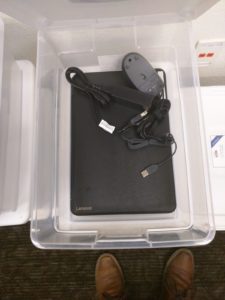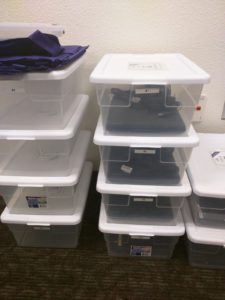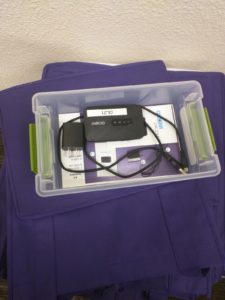In the past I have mentioned the Discovery Labs that ExploraConnect (The name of the NDIA pilot project run from Explora Science Museum here in Albuquerque NM) has been testing in the field for a little time now. This is a long series of blogs that is well overdue. In it I’d like to talk about our discovery labs, what they are, how they are set up, who we are relying on to be their administrators, and how we trained those individuals to use the labs. I’ll be adding in a few notes about how these labs touch Digital Inclusion, what has happened so far, and where we see the labs in the future.
What is a discovery Lab
 At their core the Discovery Labs are essentially mobile computer labs that are easy to use and easy to administer. We purchased chromebooks and paired them with the bare essentials, mice, power cords and a box to store them in, and added a few key extras to customize each lab for where it will be used. The spirit of the lab is that it is to be used by the community where they will find the most benefit, and therefore we decided to make this lab mobile, with components and sets “kits” that are able to be lent out to the public by Lab Administrators.
At their core the Discovery Labs are essentially mobile computer labs that are easy to use and easy to administer. We purchased chromebooks and paired them with the bare essentials, mice, power cords and a box to store them in, and added a few key extras to customize each lab for where it will be used. The spirit of the lab is that it is to be used by the community where they will find the most benefit, and therefore we decided to make this lab mobile, with components and sets “kits” that are able to be lent out to the public by Lab Administrators.
 The discovery labs have some interchangeable parts to make them more relevant for different organizations. The first addition is a hotspot kit that we can add to the Lab when the institution that is administering it wishes to lend devices to families that may not have home internet. I’ll go into the more complete process of lending a hotspot to a family in a future blog post. The second interchangeable component is a Makey Makey device. This is a very simple (and fun) microcontroller that Explora uses for many of our in classroom explorations, and now even our outreach programming as well. The last interchangeable components are not physical things; they’re chrome licences. These licences help us to manage the devices remotely, and to build customized educational scaffolding for each lab. Again, I will go into more detail in a further blog post.
The discovery labs have some interchangeable parts to make them more relevant for different organizations. The first addition is a hotspot kit that we can add to the Lab when the institution that is administering it wishes to lend devices to families that may not have home internet. I’ll go into the more complete process of lending a hotspot to a family in a future blog post. The second interchangeable component is a Makey Makey device. This is a very simple (and fun) microcontroller that Explora uses for many of our in classroom explorations, and now even our outreach programming as well. The last interchangeable components are not physical things; they’re chrome licences. These licences help us to manage the devices remotely, and to build customized educational scaffolding for each lab. Again, I will go into more detail in a further blog post.
In keeping with the spirit of the labs they are first meant to live in the communities that they serve with local stakeholders who have agreed to administer the labs, and second they are meant to be lent out to the community in individual kits. How is this possible? The Discovery Labs are made up of individual kits, so a lab of 5 computers, 5 MakeyMakey’s and 2 mobile hotspots may be divided into 7 kits, 5 with a Chromebook-MakeyMakey pair, and 2 with mobile hotspots. These indiviual kits then can be lent out directly to community members, like Girl Scout parents, science teachers and college students.
 That’s all for this post, stay tuned next time for the second installment where I cover in more detail how we have set our labs up!
That’s all for this post, stay tuned next time for the second installment where I cover in more detail how we have set our labs up!
